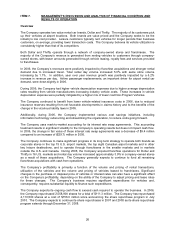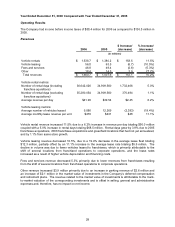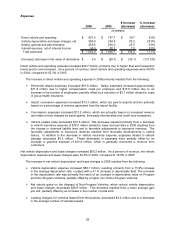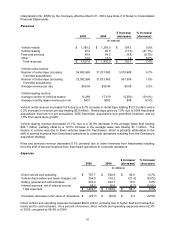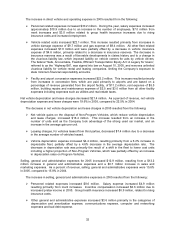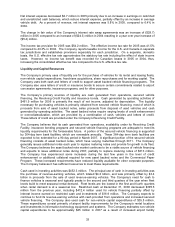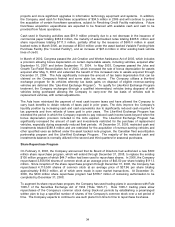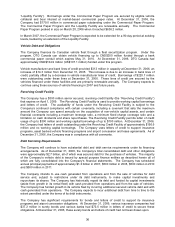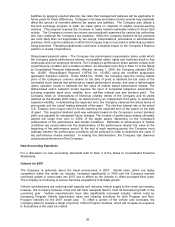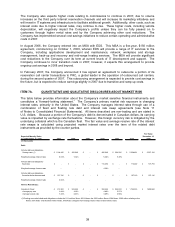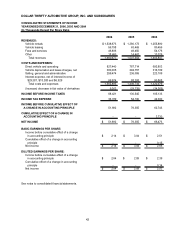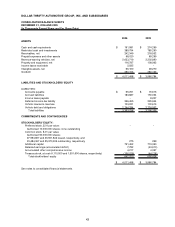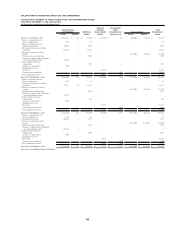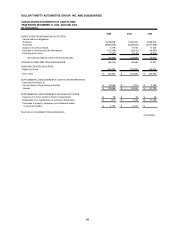Thrifty Car Rental 2006 Annual Report Download - page 42
Download and view the complete annual report
Please find page 42 of the 2006 Thrifty Car Rental annual report below. You can navigate through the pages in the report by either clicking on the pages listed below, or by using the keyword search tool below to find specific information within the annual report.“Liquidity Facility”). Borrowings under the Commercial Paper Program are secured by eligible vehicle
collateral and bear interest at market-based commercial paper rates. At December 31, 2006, the
Company had $179.0 million in commercial paper outstanding under the Commercial Paper Program.
The Commercial Paper Program and the Liquidity Facility are renewable annually. The Commercial
Paper Program peaked in size on March 28, 2006 when it reached $636.2 million.
In March 2007, the Commercial Paper Program is expected to be extended for a 90-day period at existing
levels, backed by an extension of the Liquidity Facility.
Vehicle Debt and Obligations
The Company finances its Canadian vehicle fleet through a fleet securitization program. Under this
program, DTG Canada can obtain vehicle financing up to CND$300 million funded through a bank
commercial paper conduit which expires May 31, 2010. At December 31, 2006, DTG Canada had
approximately CND$124.9 million (US$107.1 million) funded under this program.
Vehicle manufacturer and bank lines of credit provided $312 million in capacity at December 31, 2006, an
increase of $14.3 million from December 31, 2005. This increase is due to an increase in bank lines of
credit, partially offset by a decrease in vehicle manufacturer lines of credit. Borrowings of $220.7 million
were outstanding under these lines at December 31, 2006. These lines of credit are secured by the
vehicles financed under these facilities and are primarily renewable annually. The Company expects to
continue using these sources of vehicle financing in 2007 and future years.
Revolving Credit Facility
The Company has a $300 million senior secured, revolving credit facility (the “Revolving Credit Facility”)
that expires on April 1, 2009. The Revolving Credit Facility is used to provide working capital borrowings
and letters of credit. The availability of funds under the Revolving Credit Facility is subject to the
Company’s continued compliance with certain covenants, including a covenant that sets the maximum
amount the Company can spend annually on the acquisition of non-vehicle capital assets, and certain
financial covenants including a maximum leverage ratio, a minimum fixed charge coverage ratio and a
limitation on cash dividends and share repurchases. The Revolving Credit Facility permits letter of credit
usage of up to $300 million and working capital borrowings of up to $100 million. At December 31, 2006,
the Company had letters of credit outstanding under the Revolving Credit Facility of approximately $156.6
million and no working capital borrowings. The Company uses letters of credit to support insurance
programs, asset backed vehicle financing programs and airport concession and lease agreements. As of
December 31, 2006, the Company was in compliance with all covenants.
Debt Servicing Requirements
The Company will continue to have substantial debt and debt service requirements under its financing
arrangements. As of December 31, 2006, the Company’s total consolidated debt and other obligations
were approximately $2.7 billion, all of which was secured debt for the purchase of vehicles. The majority
of the Company’s vehicle debt is issued by special purpose finance entities as described herein all of
which are fully consolidated into the Company’s financial statements. The Company has scheduled
annual principal payments of approximately $1.2 billion in 2007, $500 million in 2008, $500 million in 2010
and $500 million in 2011.
The Company intends to use cash generated from operations and from the sale of vehicles for debt
service and, subject to restrictions under its debt instruments, to make capital investments and
repurchase its shares. The Company has historically repaid its debt and funded its capital investments
(aside from growth in its rental fleet) with cash provided from operations and from the sale of vehicles.
The Company has funded growth in its vehicle fleet by incurring additional secured vehicle debt and with
cash generated from operations. The Company expects to incur additional debt from time to time to the
extent permitted under the terms of its debt instruments.
The Company has significant requirements for bonds and letters of credit to support its insurance
programs and airport concession obligations. At December 31, 2006, various insurance companies had
$37.2 million in surety bonds and various banks had $72.5 million in letters of credit to secure these
obligations. At December 31, 2006, these surety bonds and letters of credit had not been drawn upon.
36


